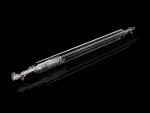I am planning to build a CO2 laser from scratch (literally producing the gas and filling the tube etc...) and wanted to ask about what to use for the inner tube (the one with CO2 in it) in terms of materials, what kind of optics setup to use, and what to do for the power supply (i.e. voltages needed, materials to use for electrodes etc.).
I am aware that it would probably be easier, cheaper, and quicker to just buy a prebuilt one, but I enjoy building things, and have just always wanted to make a gas laser.
I am aware that it would probably be easier, cheaper, and quicker to just buy a prebuilt one, but I enjoy building things, and have just always wanted to make a gas laser.







